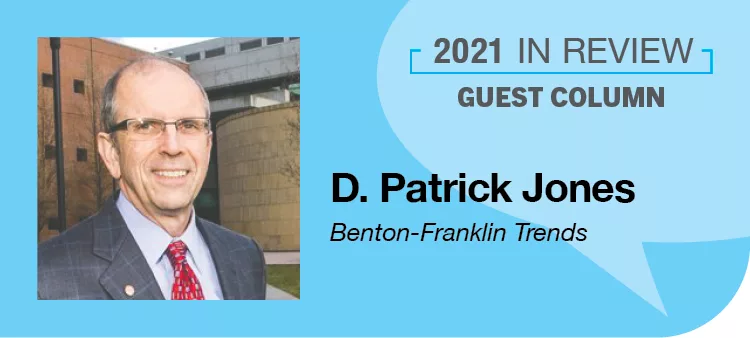
Home » As we say farewell to 2021, let’s mark return to longer-term trends
As we say farewell to 2021, let’s mark return to longer-term trends

December 15, 2021
Many things are asked of economists. Sometimes it’s to provide an explanation of the present. Other times it’s to give a forecast. This column contains a bit of both. To summarize the past year involves dissecting some of the present and poring over available evidence to forecast possible outcomes for 2021.
The challenge lies in the delay, which is often lengthy, in the release of public economic data. The lags can stretch six to nine months for many local indicators. For a few, like unemployment estimates, we are fortunate they arrive with a two-month lag. But speedy releases aren’t typical.
To some, this tardiness might seem slothful. But consider the complexity of measuring income. To arrive at trustworthy numbers, federal economists use either a raft of records from various agencies, or field the largest continuing survey in the world, involving 3.3 million U.S. residents. The first measure, “personal income,” comes from the U.S. Department of Commerce. The second, median household income, comes from the American Community Survey of the U.S. Census.
This column will focus the former measure, recently released for 2020. Specifically, we’ll examine Benton-Franklin Trends’ per capita personal income data. Income, whether at the level of the individual or the household, is akin to a “climax species” measure, one that summarizes much.
Per capita income provides an average since it divides all income flowing to individuals by the total population. As such, it gives a “middle value” of tens of thousands of individual incomes within the two counties. Averages, especially for income, however, can be swayed by high values.
Per capita personal income, or PCPI, can be skewed by age as well. A community with a large share of the population not working will typically deliver lower numbers than one where a higher percentage of the population is employed.
This applies to the greater Tri-Cities, which has a disproportionately large share of the population under 17 and presumably not working. As a consequence, per capita personal income here consistently lies below the U.S. average, as the graph illustrates. This standing is reversed for median household income, where the unit is not a person but an entire household.
Nonetheless, this column will take up PCPI because the data is newer and its components permit some forecast for final results in 2021.
The obvious fact for 2020 PCPI in the two counties was its value: slightly more than $49,000. This represents a substantial improvement from 2019, when it stood at about $45,400.
The implied increase, 8%, was far greater than the compounded growth rate of 3.2% since 2000. And the recent year-over-year increase was considerably higher than those of the U.S. and Washington.
While not shown in the Trends data, some unusual components undergird the 2020 result.
Total personal income can be thought of as a three-legged stool, with the following legs, listed in order of size: earnings (wages & salaries, plus proprietors’ income); federal transfer payments; and investment returns.
Federal transfer payments encompass a huge array of government programs.

Listed in order, the top 8 consist of Social Security, Medicare, Medicaid, student assistance, civil service retirements, veterans’ compensation, food stamps (SNAP) and VA payments. These do not include payments to federal enterprises.
In 2020, the components experienced dramatic turns of fortune. Year-over-year growth was 5% for wages and salaries, 0.7% for investment income and 32% for federal transfer payments.
The size of the federal transfer payments reflects the extraordinary lengths that the U.S. government took to buttress the economy.
From 2011-19, their average share of total income was about 19%; in 2020 it grew to 23%.
Equivalently, $3.4 billion flowed to the greater Tri-Cities economy courtesy of federal government payments to individuals. Without this dramatic opening of federal spigots, above-trend personal income would not have occurred here.
And for 2021? With so little data available, precise predictions at this point are perilous. Yet, it’s helpful to keep in mind that personal income in the greater Tri-Cities is highly correlated with that of the U.S. For sure, one of its components will be lower in 2021: transfer payments. Investment income should be higher than 2020 unless the stock market suffers a sharp pullback by year-end.
And earnings? Net farm income, part of earnings, looks to increase nicely, if the local agricultural economy follows USDA national predictions. Non-farm proprietors’ income, larger than net farm income, has been more stable and will likely grow slightly.
As for wages and salaries, the largest component of earnings, only first quarter local data have been released. Those numbers actually reveal a slight decline.
If, however, wages and salaries roughly follow the national trend, look for high single-digit increases in subsequent quarters.
Nationally, wages and salaries in the second and third quarters of this year rose 12.3% and 9.7%, respectively. Current fourth quarter national predictions about the broader measure, income, run from 5% (Blue Chip consensus) to 8% (Atlanta Federal Reserve Bank). If the forecasters are correct, Tri-City personal income should rise by mid-single digits during the final three months.
The economy of the greater Tri-Cities has been on a bumpy ride over the past 18 months. As we say goodbye to 2021, we mark the beginning of a return to longer-term trends. That’s not a bad prospect.
Patrick Jones is the executive director for Eastern Washington University’s Institute for Public Policy & Economic Analysis. Benton-Franklin Trends, the institute’s project, uses local, state and federal data to measure the local economic, educational and civic life of Benton and Franklin counties.
Year in Review
KEYWORDS december 2021





